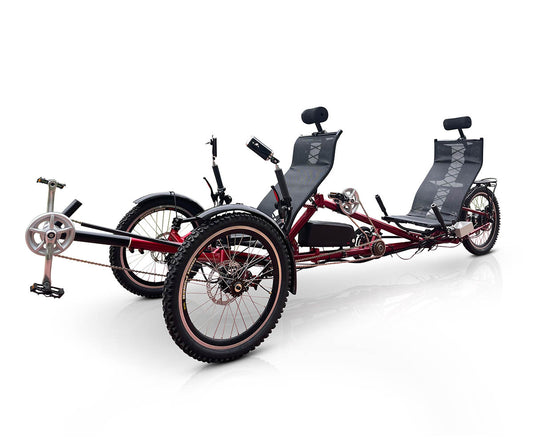
Riding Redefined: How Recumbent Quads Are Changing the Cycling Experience
Share
Exploring the world of cycling from a fresh perspective, recumbent quads offer a unique blend of comfort, stability, and efficiency. This introduction to recumbent quads delves into their design philosophy, setting the stage for a deeper understanding of why these vehicles represent more than just an alternative mode of transport. As we explore their history, mechanics, and the benefits they provide, it becomes clear that recumbent quads are not merely a niche choice but a sophisticated solution for a diverse range of cycling enthusiasts.
What is a Recumbent Quad?
Brief History
The concept of recumbent bicycles, which laid the groundwork for recumbent quads, dates back to the 19th century. These designs were initially developed as an attempt to create a bicycle that could be ridden with more comfort and less aerodynamic resistance. The first commercially available recumbent bicycles appeared in the 1930s, designed by Charles Mochet. His innovations helped pave the way for future developments in multi-wheeled recumbent vehicles, including quads. The recumbent quad itself is an evolution of these designs, providing enhanced stability and comfort by integrating an additional set of wheels, adapting the recumbent bicycle for those seeking a safer, more comfortable alternative to traditional cycling. This evolution reflects a broader trend in personal mobility toward incorporating ergonomic and efficiency considerations.
Fun fact: early cars were quite similar to four wheeled bikes with motors, using wheels with spokes and minimal bodies styles that were not much more than bare frames with a shell.
Standard Bikes vs. Recumbent Cycles
Unlike standard bicycles that position the rider upright, often leading to discomfort on long rides due to the unnatural spinal alignment and pressure on the wrists and buttocks, recumbent cycles change the game by allowing a laid-back riding posture. This design significantly reduces body strain and increases aerodynamic efficiency. Recumbent quads take this a step further by providing a four-wheel platform that ensures unparalleled stability and comfort, making them an excellent choice for those who may experience balance issues or simply desire a safer, more comfortable ride.
Benefits of Recumbent Quads
Recumbent quads bring several distinctive advantages that set them apart from other types of bicycles and tricycles. First and foremost is their stability. The four-wheel configuration of recumbent quads provides a significantly more stable base than two or three-wheeled alternatives, making them an excellent choice for riders with balance concerns or those navigating uneven terrains. This stability doesn't just enhance safety; it can also increase the rider's confidence, allowing for a more relaxed and enjoyable experience.
Another key benefit is comfort. Recumbent quads position the rider in a natural, laid-back posture which alleviates stress on the back, neck, and shoulders. This ergonomic advantage is coupled with a seat that more closely resembles a chair than a traditional bike saddle, offering support and reducing the fatigue associated with long rides.
Lastly, efficiency is a notable advantage, particularly in models equipped with gearing and drive systems optimized for diverse riding conditions. These systems ensure that whether climbing hills or cruising on flat terrains, the rider can maintain an optimal output without excessive strain.
Types of Recumbent Quads
Recumbent quads are designed to cater to a variety of riding preferences and environments, each type offering unique features and specialized capabilities. Understanding these differences can help potential riders choose the model that best fits their needs.
- Road vs. Fat Tire: Road-oriented recumbent quads are built for speed and efficiency on paved paths. They typically feature lighter frames and smoother tires to minimize rolling resistance and maximize speed. These models are ideal for those who enjoy long-distance tours on roads or well-maintained bike paths. In contrast, fat tire recumbent quads are equipped to handle rugged terrains. Their large, wide tires offer enhanced grip and stability on surfaces like sand, mud, and snow, making them perfect for adventure cycling and off-road excursions.
- Features and Customizations: The appeal of recumbent quads lies in their extensive customization options. Many models come with adjustable frames to accommodate riders of all sizes and preferences. Advanced suspension systems can be added to improve comfort on rough terrains, while others may include integrated cargo areas for practical utility in commuting or touring. Electric assist is another popular feature, providing a boost on challenging inclines or for longer journeys, ensuring that riders can enjoy their ride without undue fatigue.
- Specialized Models for Various Use Cases: Some recumbent quads are tailored for specific uses beyond simple transportation. For example, some are designed for sport and performance, featuring aerodynamic frames and high-tech materials for competitive racing. Others prioritize comfort and accessibility, offering higher seats and more accessible entry points for riders with mobility restrictions. This variety ensures that there is a recumbent quad to suit virtually any requirement.
Where Can You Use a Recumbent Quad?
Recumbent quads can adapt to various environments, however where you’re able to take a recumbent quad and where you’re allowed to ride don’t always align. Here’s where you can enjoy these vehicles most freely:
- Urban and Suburban Streets: Recumbent quads excel in urban areas for commuting and running errands thanks to their comfort and ample storage capacity. However, it's crucial to note the legal classification of electric quads. Unlike electric trikes, which are often classified similarly to bicycles under the law, electric quads can sometimes be classified differently and not as bicycles, leading to more stringent restrictions in certain areas. For a short guide (7 minutes 19 seconds) on how to stay safe in avoiding cars while riding a recumbent bike, watch this video from Youtuber ‘Bikes, Trikes, & Razors’.
- Parks and Recreational Trails: These quads are also well-suited for leisurely rides in parks or on recreational trails. While non-motorized versions typically face fewer legal restrictions, electric quads, especially those not meeting Class 1 electric bike specifications (pedal-assist only with assistance up to 20 mph), may be limited in where they can legally travel. Classes 2 and 3, which include throttle-assisted bikes and those capable of speeds up to 28 mph, often face more significant restrictions.
- Off-Road and Adventure Trails: For those looking to venture off the beaten path, fat tire recumbent quads are designed for rough terrain, making them perfect for off-road adventures. Some feature 4x4 drive systems with multiple motors for extreme traction and power. However, the use of electric quads on these trails can again be dependent on local rules about electric bikes, particularly concerning the different classifications.
While just being responsible and considerate will take care of you most of the time, it certainly doesn’t hurt to check out the local rules for riding electric bikes and quads before you hit the road or trails. A brief peek at the local regulations can help you avoid any surprises and keep your rides smooth. You can usually find what you need with a quick search online or a chat at your local bike shop; it’s ultimately worth a little time to ride without any fuss or bother!
Note: 38 states in the United States use a 3 class system to regulate electric bike usage: For a list of which states and what kinds of bikes fall into each category → go here for more info.
Recumbent Quads vs. Recumbent Trikes
While both vehicles offer unique advantages, there are several distinctions worth noting:
- Stability and Traction: Quads generally offer more stability and better traction than trikes due to their four-wheel design. This makes them particularly advantageous in adverse weather conditions or on uneven terrain, where extra stability is crucial.
- Transportation and Storage: Trikes often have a foldable feature, making them easier to transport and store than quads. The larger, more rigid frame of a quad can pose challenges for those with limited storage space or smaller vehicles.
- Wheel Tracking and Terrain Navigation: Quads with two wheel tracks tend to navigate rough terrain more smoothly compared to trikes, which have three wheel tracks. This can make quads a better option for those regularly traversing challenging landscapes.
- Storage Capacity: Quads usually provide more storage space than trikes, making them ideal for those who need to haul gear, whether for daily commutes or long tours. This increased capacity can significantly enhance their practicality for a variety of uses.
Though recumbent trikes are more common and thus offer a wider range of options, the growing popularity of recumbent quads is leading to more choices and innovations in the market. This dynamic is gradually balancing the availability of both types of recumbent cycles, making it easier for consumers to find a model that fits their specific needs.
Use Cases for Recumbent Quads, Specifically
Recumbent quads offer unique advantages that make them particularly suitable for specific scenarios where traditional bikes or even trikes might not be as effective:
- Off-Roading Adventures: Thanks to their four-wheel stability and potential to host four fat (off road) tires, recumbent quads excel in off-road conditions. Optional 4 wheel drive systems create even greater traction when needed. The extra stability helps in navigating rough terrains, such as rocky trails, sand, and even snow, where traditional bikes would struggle. This makes them a favorite among outdoor enthusiasts who wish to explore nature without the limitations of a two-wheeled vehicle.
- Touring and Commuting: With larger storage capacity, recumbent quads are ideal for long-distance touring or daily commuting where carrying capacity is crucial. Riders can easily transport camping gear, groceries, or other essentials, making quads a practical choice for self-sufficient travelers and urban commuters looking for a car alternative.
- Accessibility: The stability and comfort of recumbent quads also make them a viable option for riders with balance issues or disabilities. The ease of mounting and dismounting, coupled with the supportive seating, offers a safer and more comfortable ride, encouraging more people to enjoy cycling regardless of their physical capabilities.
The Mechanics of Recumbent Quads
Understanding the mechanical intricacies of recumbent quads provides insights into why they perform differently from trikes:
- Drive System: Typically, recumbent quads are equipped with a chain drive system that powers one or both axles, generally the rear. This setup mirrors that of some motorized four-wheel vehicles, providing efficient power transfer and simplified maintenance compared to more complex all-wheel-drive systems.
- Stability and Handling: The four-wheel design significantly enhances stability, eliminating much of the tip-over risk associated with trikes. This feature is especially beneficial in less-than-ideal cycling conditions—such as wet or icy roads—where extra traction and stability can prevent accidents.
- Suspension Systems: Many recumbent quads come with full suspension systems (As opposed to rear suspension only), absorbing shocks from all directions. This not only adds to the comfort during rides over uneven surfaces but also improves handling by keeping all four wheels in contact with the ground more consistently than trikes.
- Overall Design Considerations: The broader wheelbase and lower center of gravity in quads contribute to a smoother ride, reducing the physical stress on the rider’s body and allowing for longer durations in the saddle without discomfort.
These mechanical features highlight why recumbent quads are not just an alternative form of transportation but a distinctly advantageous one under the right circumstances. Their design and capabilities make them particularly suited for riders looking for stability, comfort, and utility in diverse environments.
Ready to Roll: Next Steps in Your Recumbent Quad Journey
As we've briefly toured the world of recumbent quads, we've uncovered their unique blend of stability, comfort, and versatility. These four-wheeled marvels aren't just about leisurely park rides or smooth commutes; they're about expanding your horizons on four wheels with confidence and ease. Whether you're tackling rugged trails or weaving through city streets, recumbent quads offer a reliable and enjoyable way to stay active and engaged in your environment.
If this peek into the quad life has sparked your interest, there's plenty more to explore. Our collection of detailed articles offers deeper dives into specific models, advanced features, and user guides to help you find the perfect fit for your lifestyle. And when you're ready to take the next step, our marketplace is stocked with options that cater to both new riders and seasoned cyclists looking to upgrade their ride. From sleek road quads to robust off-road beasts, the perfect quad awaits to transform your cycling experience.
Why wait? Dive deeper into our resources to learn more, or browse the marketplace to see the innovative designs available. Your next great adventure on wheels is just a click away—embrace the quad life and ride beyond limits!


